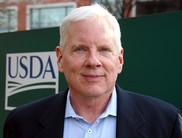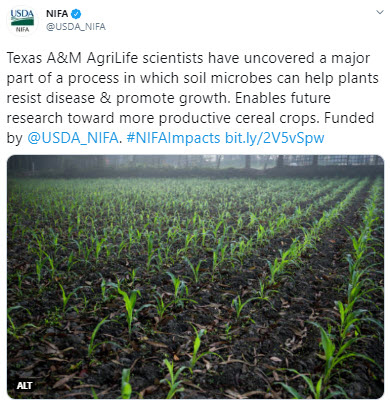|
Having trouble viewing this email? View it as a Web page.

|
|
|
Editor: Kelly Sprute April 8, 2020
Making a Difference
 Woman filling a glass of water. Image courtesy of Getty Images.
Research Leads to New Drinking Water Standard in New Hampshire
Reducing Arsenic Results in Substantial Public Health and Economic Benefits
The state of New Hampshire has adopted a new, lower drinking water standard for arsenic after University of New Hampshire (UNH) researchers found Granite Staters would be willing to invest in water treatment infrastructure improvements that make drinking water safer and avoid the substantial negative health effects of high arsenic levels.
Arsenic naturally occurs in ground water, surface water, and many foods. The Environmental Protection Agency classifies arsenic as a human carcinogen; consuming water containing arsenic over a long period of time increases risk of bladder, lung, and skin cancer as well as cardiovascular disease. It also has been linked to increased risk of adverse birth outcomes, developmental disabilities, and loss of cognitive skills.
In 2018, the New Hampshire Department of Environmental Services asked UNH researchers to estimate the economic value of lowering allowable arsenic content in New Hampshire’s municipal water systems from 10 ppb to 5 ppb. While beneficial for health reasons, tightening the water standard would result in additional treatment costs. This material is based upon work supported by the NH Agricultural Experiment Station, through joint funding of the National Institute of Food and Agriculture, under award number 1015411, and the state of New Hampshire. For the full story read the UNH article.
|
|

On April 16 from 2-3 p.m. Central time, NIFA will host a webinar for our Land Grant University and other science partners to clarify answers to frequently asked questions about how the current situation caused by COVID-19 will affect NIFA programs. Please register if you would like to attend. Also, kindly send any questions that you have, in advance, to my Chief of Staff, Bill Hoffman.
|

Meet NIFA’s Acting Congressional and Stakeholder Affairs Officer
For the past four years, Mitch Adams has worked for USDA’s Food Safety and Inspection Service (FSIS) as a Legislative Analyst. In this role, Mitch served as the liaison on legislative matters with Congress, various Executive Branch agencies and other USDA departments.
Prior to his time with FSIS, Mitch worked for the House of Representatives for eight years, advising two Members of Congress from his home state of Iowa. In these roles, he served as the Senior Legislative Assistant focusing on agriculture, energy, transportation, and environmental issues. Mitch has worked successfully with federal agencies, congressional leadership, local and state governments, community leaders, organizations, and institutions to address priorities important to constituents across Iowa. He is proud to come from one of the nation's leading agricultural and energy producing states.
|

USDA’s Work During COVID-19
This week on the Sonnyside of the Farm, Secretary Perdue talks about the work USDA is doing during the Coronavirus pandemic. From feeding kids across the country, to ensuring America’s food supply chain remains safe and strong, and making certain our farmers have enough ag workers for harvest – USDA continues its mission to “Do Right and Feed Everyone.” Listen to Sonnyside podcast.
|

Repurposing Straw Lets Farmers Grow More Food with Less Water and Fertilizer
Methods used to feed people, like land converted for farming and greater use of fertilizers, can lower biodiversity and jeopardize the sustainability of agricultural ecosystems. Scientists are looking for better ways to feed the planet. Researchers at the Florida A&M University-Florida State University’s College of Engineering explored a possible solution that uses straw from crops like rice, wheat, corn, and others to create a tool that will help crops retain water and nutrients. Existing hydrogels used in farming are typically made from petroleum products; they can be expensive, toxic and have difficulty degrading. But straw left over from processing various crops is rich in cellulose, which can be made into hydrogels that are biodegradable and therefore kinder to the environment. This research was supported by USDA’s National Institute of Food and Agriculture. Read the full FAMU-FSU article.
Rice straw stacked in a field. Image courtesy of Wikimedia Commons.
|
Land Grant University Impacts
Demonstrating the value of land-grant Extension program impacts. Enjoy the YouTube video.

Revolutionizing the World’s Inefficiencies in Fish Farming
Aquaculture and especially fish farming, play a key role in securing food security in the United States and around the world. However, for fish farming to be sustainable and economically viable, drastic improvements to current labor-intensive and resource-inefficient operations are required.
Florida Atlantic University’s (FAC) associate research professor at Harbor Branch Bing Ouyang and team or researchers are deploying a solution with a $1.2 million, four-year integrative project grant from the United States Department of Agriculture’s National Institute of Food and Agriculture in collaboration with the National Science Foundation. Read the full FAC article.
Paul Wills stands next to Bing Ouyang. Image courtesy of Florida Atlantic University.
|
Food and Agriculture Service Learning Program
The Food and Agriculture Service Learning Program increases the knowledge of agricultural sciences and improves the nutritional health of children through food, garden, and nutrition education within host organizations. This program fosters a higher level of community engagement between farms, school systems, and brings together stakeholders from all parts of the food system. The initiative is part of a broader effort to increase access and improve the quality of school meals for low-income children. For more information read the Food and Agriculture Service Learning funding opportunity.
Community Food Projects Competitive Grants Program
NIFA's Community Food Projects (CFP) intends to solicit applications and fund two types of grants. The types are:
- Community Food Projects (CFP) and
- Planning Projects (PP).
CFP supports the development of projects with a one-time infusion of federal dollars to make such projects self-sustaining. CFPs are designed to create community-based food projects with objectives, activities and outcomes that are in alignment with Community Food Projects Competitive Grants Program (CFPCGP) primary goals. Planning Projects complete a plan toward the improvement of community food security in keeping with the primary goals of the CFPCGP. Planning Projects focus on a defined community and describe in detail the activities and outcomes of the project. For more information read the full CFP funding opportunity.
Update to the Gus Schumacher Nutrition Incentive Program Formerly known as the Food Insecurity Nutrition Incentive Program (FINI)
The Gus Schumacher Nutrition Incentive Program supports projects to increase the purchase of fruits and vegetables among low-income consumers participating in the Supplemental Nutrition Assistance Program (SNAP) by providing incentives at the point of purchase. NIFA will give priority to projects that have demonstrated the ability to provide services to underserved communities and/or economically distressed communities, particularly Opportunity Zones. Read the full GusFini funding opportunity.

|
|
|
NIFA’s mission is to invest in and advance agricultural research, education, and extension that solve societal challenges. NIFA’s investments in transformative science directly support the long-term prosperity and global preeminence of U.S. agriculture. Keep informed about NIFA, USDA, our land-grant and non-land-grant university partners, and stakeholders with the NIFA Update. Read past issues online, sign up for email updates or follow us on Twitter @USDA_NIFA, #NIFAImpacts or LinkedIn @usda-nifa.
If you wish to submit a news item or information, send an email to NIFAUpdate.
USDA is an equal opportunity lender, provider, and employer.
|
|
|
|